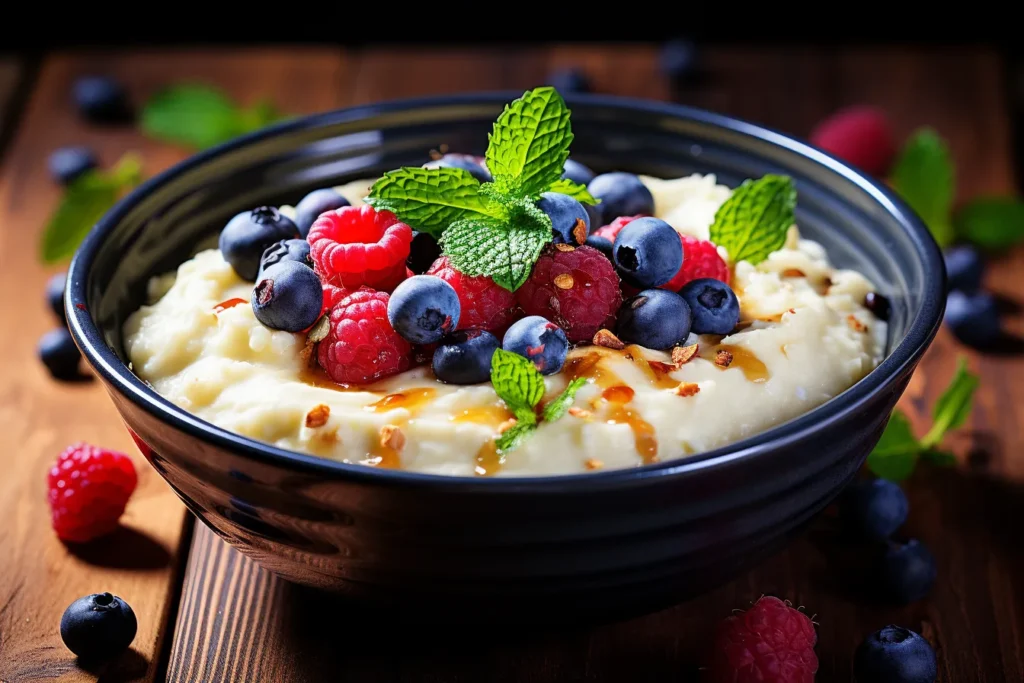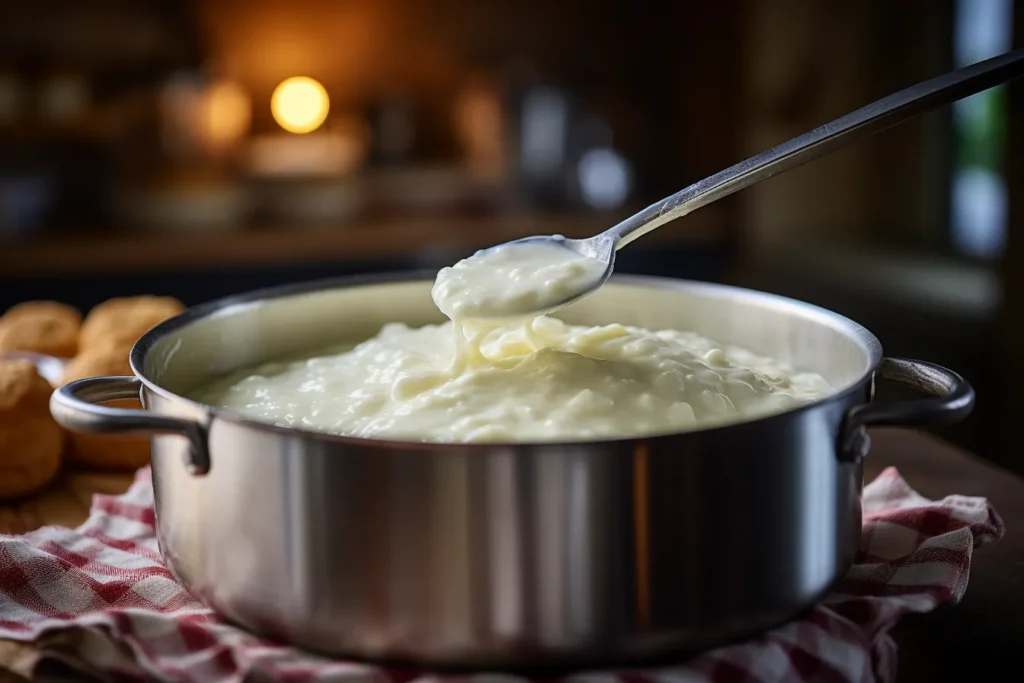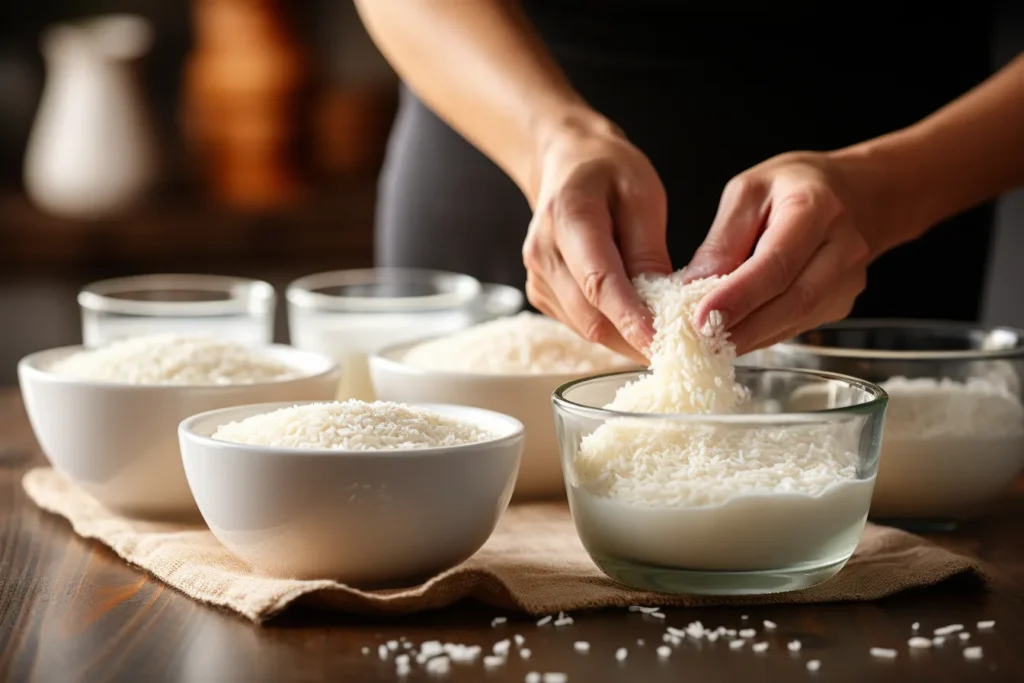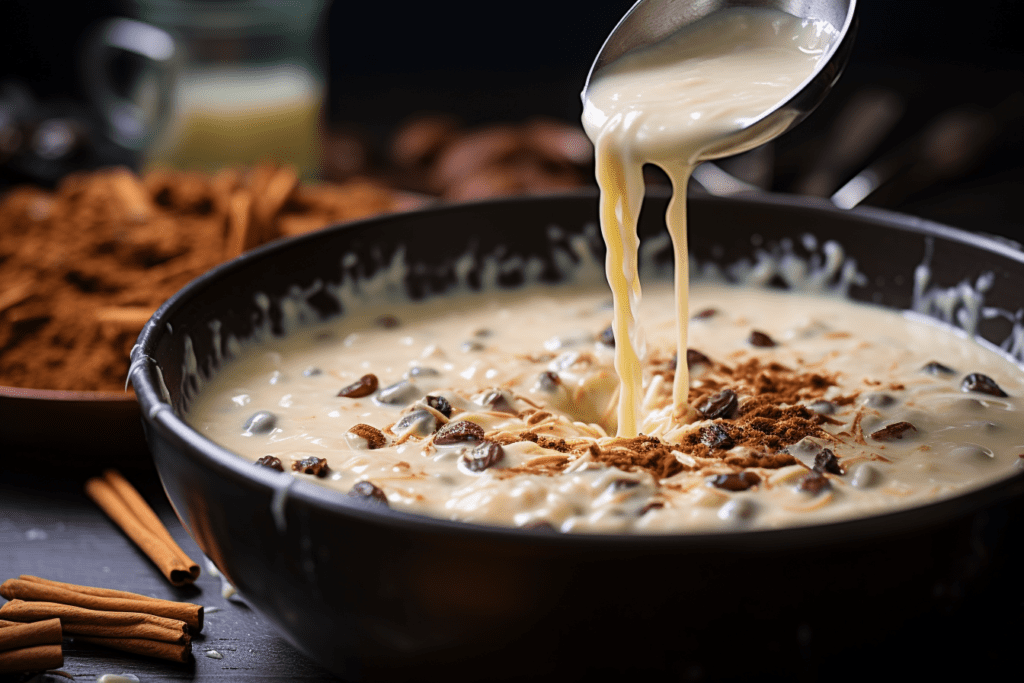Introduction
is rise pudding healthy ? This classic dessert combines simple ingredients like rice, milk, and sugar, making it a favorite worldwide. While its creamy texture and rich taste might feel indulgent, rice pudding can offer surprising nutritional benefits when prepared mindfully. With a balance of slow-digesting carbohydrates, protein, and calcium, it has the potential to be both satisfying and nourishing.
Understanding whether rice pudding is healthy comes down to the ingredients and portions. By choosing low-fat milk, reducing added sugar, or incorporating plant-based alternatives, you can turn this dessert into a wholesome option. For those managing weight or monitoring blood sugar, tweaking the recipe makes a big difference
In this article, we’ll explore the nutritional profile of rice pudding, its potential health benefits, and ways to enjoy it without guilt. From healthy recipe tips to dietary customizations, this guide will help you decide whether rice pudding deserves a spot in your diet.
Table of contents

Ingredients
To make rice pudding that balances both flavor and health, it’s essential to choose high-quality ingredients. The beauty of this dish lies in its simplicity, but every ingredient plays a significant role in the final result. Let’s break down the components and discuss their roles, substitutions, and ways to make them healthier.
Main Ingredients for rise pudding healthy
- Rice
- Role: The star of the dish, rice provides the creamy texture and bulk of the pudding.
- Best Choices: Short-grain rice, such as Arborio, is ideal because it absorbs liquid well and creates a soft, creamy consistency.
- Healthy Substitutions: For added fiber, you can use brown rice or quinoa, though the texture may be slightly different.
- Milk
- Role: Milk serves as the base liquid, creating the pudding’s rich, velvety texture. It also adds calcium and protein to the dish.
- Healthy Substitutions: Replace whole milk with low-fat, skim, or plant-based options like almond, soy, or oat milk for a lighter version. Coconut milk is also a great choice for a dairy-free, creamy alternative.
- Sweetener
- Role: Sweeteners bring out the dessert’s flavors and make it satisfying. Traditional recipes often use white sugar.
- Healthy Substitutions: Opt for honey, maple syrup, or stevia for a lower glycemic impact. You can also reduce the amount of sweetener altogether by adding naturally sweet ingredients like raisins or dates.
Time to Cook and Prep
| Task | Time Required |
|---|---|
| Preparation | 10 minutes |
| Cooking | 30 minutes |
| Total Time | 40 minutes |
Optional Additions
- Spices
- Cinnamon and Nutmeg: These spices enhance the flavor while offering antioxidants and anti-inflammatory benefits.
- Cardamom or Vanilla Extract: For a unique twist, add these for a fragrant touch.
- Fruits
- Dried Fruits: Raisins, cranberries, or chopped dates provide natural sweetness and additional fiber.
- Fresh Fruits: Top your pudding with sliced bananas, strawberries, or mango for a refreshing finish.
- Nuts and Seeds
- Almonds, Walnuts, or Pistachios: These add crunch, healthy fats, and protein.
- Chia Seeds or Flaxseeds: Mix these into the pudding for a fiber and omega-3 boost.

Tips for Adjusting to Dietary Needs
- Vegan Option
- Use plant-based milk and sweeteners like agave or coconut sugar.
- Replace butter, if used, with vegan margarine or coconut oil.
- Low-Sugar Option
- Rely on natural sweeteners like mashed bananas, or skip added sugars altogether if dried fruits are included.
- Gluten-Free Option
- Ensure your rice and any added ingredients are certified gluten-free to avoid cross-contamination.
Ingredients for rise pudding healthy
Crafting a delicious and nutritious version of rice pudding begins with carefully selected ingredients. But is rice pudding healthy? The answer lies in how these components are chosen and prepared. Each ingredient contributes to the dish’s taste, texture, and nutritional profile.
Main Ingredients: is rise pudding healthy with These Choices?

- Rice
- Role: The star ingredient in rice pudding, rice, provides the creamy texture we all love.
- Healthier Options: Traditional white rice is common, but is rice pudding healthy with brown rice? Absolutely! Brown rice adds fiber and nutrients while maintaining the pudding’s comforting appeal.
- Milk
- Role: Milk forms the liquid base, creating a smooth, velvety pudding. It also supplies calcium and protein.
- Healthy Adjustments: Low-fat milk or plant-based options like almond or soy milk can reduce calories and saturated fats. Coconut milk adds richness, making dairy-free rice pudding equally satisfying.
- Sweetener
- Role: Sweeteners add the dessert’s signature sweetness, but they can impact its healthiness.
- Better Alternatives: Is rice pudding healthy with natural sweeteners? Using honey, maple syrup, or dates instead of refined sugar lowers its glycemic impact.
Enhancing rise pudding Nutrition
- Spices
- Cinnamon and Nutmeg: These enhance flavor without adding calories, and they provide antioxidants.
- Cardamom or Vanilla: For a unique flavor, use these as natural enhancers.
- Fruits
- Dried Fruits: Raisins or dates boost sweetness while adding fiber.
- Fresh Fruits: Topping rice pudding with fruits like bananas or berries makes it refreshing and nutrient-rich.
- Nuts and Seeds
- Almonds or Walnuts: These introduce crunch, healthy fats, and protein.
- Chia Seeds: Adding chia seeds boosts omega-3 content and creates a thicker texture.
Diet-Specific Variations: is rise pudding healthy for Everyone?
- For Vegans
- Use plant-based milk, like oat or coconut, and sweeten with agave or maple syrup.
- For Weight Watchers
- Replace sugar with mashed bananas or unsweetened applesauce to reduce calorie intake.
- For Gluten-Free Diets
- Rice pudding is naturally gluten-free, but confirm that all added ingredients, like spices, are certified gluten-free.
Preparation rise pudding healthy
Making rice pudding at home is a simple yet rewarding process. By adjusting the recipe to your preferences, you can answer the question: is rice pudding healthy for your lifestyle? Let’s go step-by-step to ensure you achieve the perfect texture, taste, and nutritional balance.
Gather the Tools and Ingredients
To prepare rice pudding, you’ll need the following tools:
- A heavy-bottomed saucepan: Prevents the pudding from sticking or burning.
- A wooden spoon: Ideal for stirring consistently.
- Measuring cups and spoons: Ensures accurate ingredient proportions.
- A ladle or serving bowl: For plating your rice pudding when it’s ready.
Additionally, collect your ingredients: rice, milk (or alternative), sweetener, and any add-ins like spices, fruits, or nuts.
Cook the Rice

- Wash the Rice
- Start by rinsing the rice under cold water until the water runs clear. This step removes excess starch, which can make the pudding too sticky.
- Cook the Rice in Water or Milk
- Add 1 cup of rice to 2 cups of water (or milk for a creamier base) in the saucepan. Bring it to a boil, then reduce the heat to low and cover. Simmer for 15–20 minutes, or until the rice is tender. Remember, stir occasionally to prevent sticking.
Combine Ingredients
- Add Milk and Sweetener
- Once the rice is cooked, add 2 cups of milk (or plant-based alternative) to the saucepan. Stir in your sweetener of choice, such as sugar, honey, or maple syrup. For a healthier twist, consider reducing the amount of sweetener and relying on dried fruits for added flavor.
- Incorporate Spices and Flavorings
- Sprinkle in cinnamon, nutmeg, or a dash of vanilla extract. These not only enhance flavor but also add health benefits. For example, cinnamon may help regulate blood sugar levels.
Simmer and Stir
- Simmer Slowly
- Allow the mixture to simmer gently over low heat for 20–30 minutes. Stir frequently to prevent burning and ensure the rice absorbs the milk for a creamy texture.
- Adjust Consistency
- If the pudding becomes too thick, stir in an additional splash of milk to loosen it. Alternatively, if it’s too runny, continue simmering until it thickens to your liking.
Serve and Garnish
- Let It Cool Slightly
- After cooking, let the pudding rest for 5–10 minutes. This allows the flavors to meld and the texture to set.
- Add Toppings
- Serve warm or chilled, garnished with your choice of toppings. For a nutrient boost, try fresh fruits, chopped nuts, or a sprinkle of chia seeds. Alternatively, drizzle honey or a dusting of cinnamon for a simple finish.
Tips for Success
- Prevent Overcooking: Overcooking can make the rice mushy and compromise the texture. Stop cooking once the mixture is creamy but the rice grains are still distinct.
- Taste as You Go: Adjust sweetness and spice levels while cooking to suit your palate.
- Store Properly: Refrigerate leftover rice pudding in an airtight container for up to 3 days. When reheating, add a splash of milk to restore creaminess.
Cooking and Serving
Now that you’ve prepared the base for rice pudding, it’s time to elevate this dish with thoughtful cooking techniques and creative serving ideas. Whether you’re serving it as a comforting dessert or a nutritious snack, the way you cook and present rice pudding can significantly influence its healthiness and appeal. So, is rice pudding healthy? With these tips, it certainly can be!
How to Cook
| Step | Instructions |
|---|---|
| 1 | Wash the rice thoroughly under cold water to remove excess starch. |
| 2 | Cook the rice in water or milk until tender and fluffy. |
| 3 | Add milk, sweetener, and spices, then simmer for 20–30 minutes. |
| 4 | Stir frequently to avoid sticking and achieve a creamy texture. |
| 5 | Cool slightly before serving, then garnish with fruits or nuts. |
Cooking Tips for Perfect Rice Pudding
- Achieve the Ideal Creaminess
- Cook the pudding over low heat, stirring frequently. This ensures the rice absorbs the liquid evenly and results in a creamy consistency. Additionally, avoid rushing the process; slow cooking allows the flavors to develop fully.
- Experiment with Flavors
- While traditional recipes use cinnamon and vanilla, you can try unique flavors to enhance your pudding. For instance, adding cardamom gives it a Middle Eastern touch, while cocoa powder creates a decadent chocolate version.
- Monitor Sweetness
- Taste the pudding as it cooks and adjust the sweetness to your preference. For healthier options, rely on natural sweeteners like dates or a small amount of honey.
- Double-Boiler Method
- If you’re worried about burning the pudding, use a double boiler for a gentler cooking process. This method keeps the heat even and prevents scorching.
Serving Suggestions: Is Rice Pudding Healthy Enough to Enjoy Regularly?
- Serve Warm or Chilled
- Rice pudding is versatile and can be served warm for a cozy treat or chilled for a refreshing dessert. Pair it with toppings that complement the season. For example, fresh berries are perfect in summer, while spiced nuts work well in winter.
- Creative Plating Ideas
- Use small glass jars or ramekins to portion out individual servings. Alternatively, serve it in a hollowed-out fruit bowl, like a halved coconut shell or hollowed orange, for a fun twist.
- Pair with Beverages
- Rice pudding pairs beautifully with herbal teas or a cup of chai for a warming experience. For a more indulgent pairing, enjoy it with a latte or hot chocolate.
- Add Textural Contrast
- To make rice pudding more exciting, sprinkle crunchy elements like granola, toasted almonds, or crushed pistachios on top. For extra creaminess, drizzle a spoonful of coconut cream or whipped yogurt.
Variations and Customizations
Rice pudding is a versatile dish that adapts beautifully to different tastes, cultures, and dietary needs. Whether you’re looking to explore global variations or create a version tailored to specific health goals, there’s a rice pudding recipe for everyone. So, is rice pudding healthy? These customizations make it easier to enjoy while fitting your unique preferences.
Global Variations of Rice Pudding
- Indian Kheer
- Features: Kheer is made with basmati rice, milk, sugar, and aromatic cardamom. It often includes saffron and garnishes like almonds or pistachios.
- Health Tip: Swap sugar with jaggery or honey to add natural sweetness and minerals.
- Spanish Arroz con Leche
- Features: This creamy dessert combines short-grain rice, milk, sugar, cinnamon, and lemon zest.
- Health Tip: Use low-fat milk and reduce sugar for a lighter version.
- Middle Eastern Roz Bel Laban
- Features: A fragrant pudding made with rice, milk, sugar, and a hint of rose water or orange blossom water.
- Health Tip: Add a handful of crushed nuts like pistachios for texture and healthy fats.
- Scandinavian Risalamande
- Features: This Christmas dessert includes rice pudding mixed with whipped cream and topped with cherry sauce.
- Health Tip: Use Greek yogurt instead of whipped cream for a protein boost.
Dietary Customizations
- Vegan Rice Pudding
- Use plant-based milk alternatives such as almond, coconut, or oat milk. Sweeten with agave syrup or maple syrup.
- Add coconut cream for a luscious texture.
- Low-Sugar Rice Pudding
- Reduce added sugar by relying on natural sweeteners like mashed bananas or dates.
- Incorporate spices like cinnamon or nutmeg for flavor without calories.
- High-Protein Rice Pudding
- Add a scoop of protein powder (vanilla or unflavored) during cooking.
- Stir in Greek yogurt after cooling for a creamy and protein-rich version.
- Gluten-Free Rice Pudding
- Rice pudding is naturally gluten-free, but ensure all ingredients, especially flavorings and toppings, are certified gluten-free.
Creative Flavor Enhancements

- Chocolate Rice Pudding
- Add unsweetened cocoa powder or melted dark chocolate for a decadent twist.
- Sweeten lightly with honey or stevia for a healthier option.
- Fruit-Infused Rice Pudding
- Mix in fruit purees like mango or strawberry during cooking.
- Top with fresh fruits like blueberries, raspberries, or sliced peaches.
- Nutty Delight
- Stir in almond butter or peanut butter for a nutty flavor.
- Sprinkle chopped nuts like hazelnuts or pecans for extra crunch.
By experimenting with these variations and customizations, you can make rice pudding that fits your diet, satisfies your cravings, and showcases global culinary traditions. Whether vegan, low-sugar, or infused with spices, the possibilities are endless.
Serving Suggestions
The way you serve rice pudding can transform it from a simple dessert into a memorable culinary experience. With creative plating ideas, complementary accompaniments, and thoughtful garnishes, you can elevate this dish while answering the question: is rice pudding healthy? Here are serving tips that make it as visually appealing as it is delicious.
Plating Ideas for rise pudding healthy
- Individual Jars or Ramekins
- Serve rice pudding in small mason jars or ramekins for elegant, portion-controlled servings.
- Layer the pudding with fruit compotes or granola for added texture and visual appeal.
- Edible Bowls
- Use hollowed-out fruits like oranges, coconuts, or apples as edible bowls. This not only looks stunning but also adds flavor.
- For an eco-friendly option, serve in banana leaves or bamboo bowls.
- Elegant Drizzles and Sprinkles
- Drizzle honey, chocolate syrup, or fruit coulis in a zigzag pattern over the pudding.
- Sprinkle cocoa powder, cinnamon, or powdered sugar for a polished finish.
Garnishes and Toppings
- Fresh Fruits
- Top with berries, mango slices, or pomegranate seeds for a burst of freshness and color.
- Citrus zest (lemon or orange) adds a tangy contrast to the creamy texture.
- Crunchy Additions
- Crushed pistachios, roasted almonds, or granola provide a satisfying crunch.
- Coconut flakes or caramelized nuts can add sweetness and complexity.
- Whipped Cream or Yogurt
- Add a dollop of whipped cream or Greek yogurt for creaminess and visual height.
- Dust with cinnamon or nutmeg for a classic touch.
Pairing Rice Pudding with Side Dishes
- Light and Fruity Sides
- Serve with a side of mixed berry salad or a tangy fruit sorbet for balance.
- A simple fruit skewer can complement the richness of the pudding.
- Beverages to Pair
- Herbal teas like chamomile or mint pair beautifully with warm rice pudding.
- For chilled pudding, try pairing it with iced lattes or fresh lemonade.
- Savory Contrasts
- Pair with savory sides like spiced nuts or cheese platters for a contrasting flavor experience.
By focusing on thoughtful presentation and complementary pairings, you can make rice pudding a highlight of any meal. Whether served warm or chilled, its versatility shines when garnished and paired with care.
Nutritional Analysis
Understanding the nutritional value of rice pudding helps answer the question: is rice pudding healthy? The answer largely depends on the ingredients and portion size. Here’s a breakdown of its typical nutritional profile and tips for enhancing its health benefits.
Nutritional Benefits of Rice Pudding
- Energy Boosting Carbohydrates
- Rice is a primary source of carbohydrates, providing a steady release of energy.
- Using whole-grain or brown rice increases the fiber content, aiding digestion.
- Protein for Muscle Repair
- Milk and any added dairy or plant-based alternatives contribute to the protein content.
- Greek yogurt or a scoop of protein powder can further enhance protein levels.
- Calcium for Bone Health
- Milk or fortified plant-based milk is rich in calcium, which supports strong bones and teeth.
- Natural Sweeteners and Their Impact
- Substituting refined sugar with honey, dates, or maple syrup adds sweetness while offering additional nutrients like antioxidants.
Typical Nutritional Values (Per 1-Cup Serving)
Note: These values are approximate and vary based on the recipe.
| Nutrient | Amount |
|---|---|
| Calories | 200–250 kcal |
| Protein | 5–7 g |
| Carbohydrates | 35–40 g |
| Fat | 3–5 g |
| Fiber | 1–2 g |
| Calcium | 150–200 mg |
| Sugar | 10–15 g |
How to Make rise pudding healthy

- Reduce Sugar
- Use less sugar or replace it with natural sweeteners. You can also sweeten with ripe fruits like bananas or raisins.
- Choose Low-Fat or Plant-Based Milk
- Substitute whole milk with skim, almond, or oat milk to lower fat content while maintaining creaminess.
- Add Nutrient-Rich Ingredients
- Incorporate chia seeds or flaxseeds for omega-3s and fiber.
- Add cinnamon, which may help regulate blood sugar levels.
- Control Portion Sizes
- While rice pudding can be nutrient-rich, portion control is key to keeping calories in check. Serve in smaller bowls or ramekins for better control.
is rise pudding healthy
Rice pudding can be a healthy dessert or snack when prepared with mindful ingredient choices. Its balance of carbohydrates, protein, and calcium makes it a satisfying option, especially when sweetened naturally and paired with fiber-rich toppings
Sample Nutritional Table for a Healthy Rice Pudding
| Component | Amount (Per Serving) |
|---|---|
| Calories | 200 kcal |
| Protein | 5 g |
| Carbohydrates | 35 g |
| Fat | 3 g |
| Fiber | 1 g |
| Calcium | 150 mg |
This modified version ensures a lighter, nutrient-packed dessert suitable for most diets.

